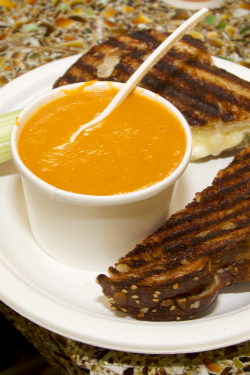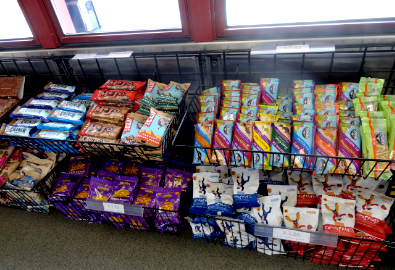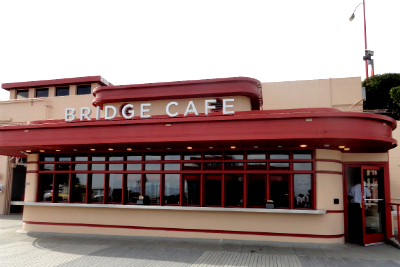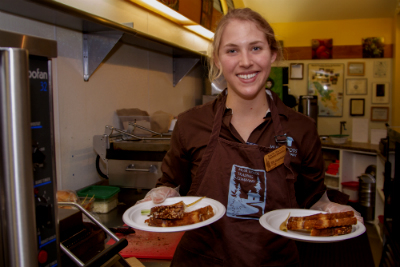
NPS moves toward sustainable healthy food
SAN FRANCISCO — About 20 miles north of the heart of San Francisco, including a final mile of winding curves through the mountains that takes visitors a couple hundred feet above sea level, is Muir Woods National Monument, a park densely packed with redwood trees reaching heights of more than 350 feet.
Almost as impressive as these towering redwoods is Muir Woods Café, an innovator in food service when it comes to the National Park Service (NPS). Here, visitors will find that local, fresh and sustainable foods are the norm.
 |
The Marin Melt at Muir Woods Café near San Francisco, made with locally sourced cheeses, is served with a cup of tomato soup. The combo is a favorite of visitors to Muir Woods and has been featured on Food Network’s “Best Thing I Ever Ate” (Courtesy Muir Woods Trading Company). |
Salads overflowing with produce grown within miles are topped with sustainably caught tuna. The Marin Melt, a grilled cheese sandwich served with tomato soup, has garnered attention from Yelp reviews and even the experts at Food Network themselves.
Muir Woods Café took on its current form after Muir Woods Trading Company won the contract to manage the location, transforming it from fast food to top-notch. Everything offered is still grab-and-go and convenient – just a lot healthier and better for the environment.
“The good news is, this has worked well at Muir Woods, and we would like to try this in other national parks as new contracts become available,” said Frank Dean, superintendent of the Golden Gate National Recreation Area, which includes Muir Woods.
Kurt Rausch, branch chief of contract management for the NPS, has written up new health standards and sustainability guidelines that will soon be followed by all concessionaires at national park sites across the United States.
“Sustainability and health often go hand-in-hand,” Rausch said. “… When we saw that happening in some concession facilities, we were interested in making sure that we were providing some continuity across the service so everybody can experience that.”
Rausch and the NPS Commercial Services Program have been working over the past few months to gather information and comments from concessionaires to ensure that new contract agreements signed according to these standards will be practical and implementable.
“Standards essentially look at some fairly basic requirements for health, including low sodium, low fat and low calorie, and also look at some cooking practices and other factors that would influence the healthiness of food, as well as identifying products that would be on the menu that are healthy,” Rausch said.
At least two healthy items that meet nutritional standards must be offered at each concession stand. Frequently this will be a vegetarian option, which was already a requirement of the food vendors, according to Rausch.
While the health standards are a requirement, the guidelines are a suggestion because not all parks have the access to locally sourced foods, according to Dean, who is the leader of the NPS Call to Action: Eat Well and Prosper.
“Locally grown in the desert is going to be much different than locally grown in California,” Dean said.
Limitations to implementing these guidelines are primarily based on distance from growers. Parks in deserts, like Death Valley, and in the middle of lakes, like Isle Royale, would be more restricted.
A number of factors have contributed to the need for changes in food at the parks. Rausch said that park employees and visitors had expressed a desire for more food options, but the transition has been happening organically already.
 |
Snack bars ranging from Clif to Odwalla are healthier alternatives to baked goods sold at many food service providers at other national parks (Photo by Lyssa Goldberg). |
“A lot of our concessionaires were already moving particularly toward sustainable food because the park service mission focuses a lot about environmental footprint and how we can minimize that through the quality of the services we provide,” he said.
The argument has been made that, when people are visiting the parks on vacation, they want to have fun and may prefer to eat fries or ice cream, according to Dean. That is why this new change is all about choices.
“If you want to have French fries and a hamburger, you can have that, but if you want a healthier choice, that will now be available, too,” Dean said. “In the case of Muir Woods, we kind of aired on the side of more healthy than not.”
Providing these options is a significant opportunity, Rausch said.
“At many parks, they are the only food and beverage location within a significant range, and so it’s appropriate for us to make sure that there’s some options that folks have,” he said.
Dean said that he thinks the public is ready for this change.
“If you look at the rise in farmers markets across the country, in almost every community, some type of farmers market has come back,” he said. “People want to know where their food is coming from. They want to have choice.”
Café Upon a Hill
The Muir Woods Café serves as the model for vendors at national parks across the country. Its former traditional set-up meant that park visitors could smell the scent of tempting – but unhealthy – baked goods throughout the woods, according to Dean.
“You didn’t come to Muir Woods to smell that. You came to smell the aroma of the creek and the trees and the natural world,” Dean said. “People certainly bought those brownies and muffins when they were there, but we’re trying to create more of a natural setting and experience for people.”
Muir Woods Trading Company won the contract by coming up with a plan that would meet the mark for healthy food, but it has gone above and beyond.
“The concession building is right in the heart of the redwood grove area,” Dean said. “So out of respect for the environment, they do some of their kitchen prep off-site at a different location and bring it in.”
This eliminates odors from the cooking, and the company also has requirements for water, energy, and even waste, according to Dean.
|
Muir Woods Café uses an Easy as 1, 2, 3 disposal system that separates recyclables, compostable items and landfill trash (Photo by Lyssa Goldberg). |
 |
Muir Woods Café employs an “Easy as 1, 2, 3” trash disposal system, dividing waste into three separate containers for compostable items, recyclables and remaining materials that go into a landfill. Because of this, 85 percent of the waste at the park is recycled or composted, according to a Food for the Parks report.
Disposable cups are sold for 25 cents each – making the guests at the park more conscious of their consumption.
The café is also a leader in food sustainability, with all of their food grown within California, most within the same county, according to the same report. Companies such as Point Reyes Farmstead and Cowgirl Creamery are two local suppliers.
According to Dean, 75 percent of the produce and protein is brought from less than 80 miles away, and 90 percent of it is USDA-certified organic.
Dean believes that visitors are receptive to the idea of healthy and sustainable food at Muir Woods because of their vacation mindset.
“I think sometimes when people are on vacation, they’re more open-minded and want to learn something new, maybe … actually never tried this before and think, ‘Oh, I really like the way this tastes. I’ll try to make this when I get home,’” he said.
Other Parks
As superintendent of the Golden Gate National Recreation Area, Dean has also seen improvement at one of the food outlets at the south end of the Golden Gate Bridge. Since May 2012, Bridge Café, a grab-and-go snack bar, has featured healthier items.
“We took out all of the fast food, junk food, and we don’t sell carbonated soft drinks there,” Dean said. “We have healthy snacks like granola bars and pretzels and baked items instead of fried.”
At the Grand Canyon, efforts have included adding calorie counts to the menu and highlighting sustainable food items, according to Robin Martin, deputy chief of concessions at the Grand Canyon.
Good Provisions’ Snack Foods and the historic Lodge Dining Room are two Grand Canyon food providers touting such quality ingredients.
 |
Bridge Café at Golden Gate National Recreation Area underwent a healthy update in May 2012. The new menu highlights healthy, affordable grab-and-go items featuring locally sourced ingredients (Photo by Lyssa Goldberg). |
“One of the most important parts is identifying them on the menus so it can be kind of like a learning or interpretative educational tool for people,” Martin said. “So they understand what they’re eating or the health value of what they’re eating.”
At Yosemite, visitors to the park can access an “Eat Well Play More” dining guide that offers information on the proportion of locally sourced foods, organic products, humanely produced meats and beyond.
“This dining guide makes it easy for park visitors to choose a food venue based on healthy and sustainable food options with a chart that plots healthy options available at each location with a corresponding color-coded map that displays adjacent activities,” said Lisa Cesaro, a representative of DNC Parks & Resorts, the concessionaire at Yosemite.
Six of the nearly 20 food locations at Yosemite – including delis, grills, restaurants bars and more – feature a menu with more than 40 percent of foods coming from the local area.
Evolution of the Initiative
The Institute at Golden Gate, a program of the Golden Gate National Parks Conservancy (GGNPC), has led the Food for the Parks initiative to expand the availability of nutritious, healthy, local and sustainable food in parks nationwide.
According to Melissa Tsang, Food for the Parks coordinator at GGNPC, the success of Muir Woods inspired those at the institute to look across the nation to see if other parks were doing similar things.
The institute shared its findings in a report called “Food for the Parks: Case Studies of Sustainable Food in America’s Most Treasured Places.” It highlights parks and concessionaires with healthy and sustainable food programs in place.
“We got a lot of questions, like ‘How did you do this? What practices did you use?’ … That inspired us to produce our follow-up report,” Tsang said.
Published in response to the feedback on the first report, the “Food for the Parks: A Roadmap to Success” serves as a step-by-step guide on how to make improvements in the food offerings at the NPS sites. It offers information on everything from conducting a sustainability self-assessment to offsetting increased food costs.
“It’ll transform parks into a destination where you don’t just go to recreate, but the food served there represents America’s best of what we have to offer,” Tsang said.
At a Health Parks Healthy People U.S. conference hosted at Golden Gate National Recreation Area in April 2011, NPS Director Jon Jarvis expressed his support for the initiative.
“At that meeting, he recognized that serving healthy foods to our park visitors was important so he made a formal statement and a commitment,” Tsang said.
|
An employee at Muir Woods Café holds two freshly prepared sandwiches. Most food items are prepared off-site in order to prevent the odors from penetrating the natural environment, but the sandwiches are grilled at the café (Courtesy Muir Woods Trading Company). |
 |
This is what eventually led to the revised food health standards and sustainability guidelines of the NPS. Tsang enjoys knowing that the Food for the Parks initiative has evolved into a national commitment to healthy food.
“To be able to provide food that matches the healthy and outdoor experience that we’re hoping that people engage in is really exciting,” she said.
In March, the institute will host a summit on sustainable food service and convene leaders and change-makers in other industries.
“Some of the challenges are the same: sourcing, pricing, meeting customer preferences,” Tsang said.
SUSTAINABLE HEALTHY EATING AT NATIONAL PARKS
Crocker Dining Hall
Asilomar State Beach and Conference Grounds
Pacific Grove, Calif.
Muir Woods Café
Muir Woods National Monument
Golden Gate National Recreation Area
Marin, Calif.
Bridge Café
Golden Gate Bridge
Golden Gate National Recreation Area
San Francisco, Calif.
Yosemite Dining
Yosemite National Park
Yosemite Village, Calif.
Grand Teton Concessions
Grand Teton National Park
Moose, Wy.
Yellowstone Lodges, Whoa Neli Deli
Yellowstone National Park
Northwest Wyoming, Southwest Montana
Grouse Mountain Lodge and St. Mary Lodge
Glacier National Park
Columbia Falls, Mont.
Mount Rushmore Carvers Café
Mount Rushmore National Park
Black Hills, S.D.
Zion Lodge
Zion National Park
Springdale, Utah
Countryside Initiative
Cuyahoga Valley National Park
Cuyahoga Valley, Ohio
Fort McHenry Visitors Center
Fort McHenry National Monument
Baltimore, Md.
Roxbury Farm
Martin Van Buren Historic Site
Kinderhook, N.J.
Greenway Open Market
Rose Kennedy Greenway
Boston, Mass.
Jordan Pond House Restaurant
Acadia Naitonal Park
Seal Harbour, Maine

Comments are Closed